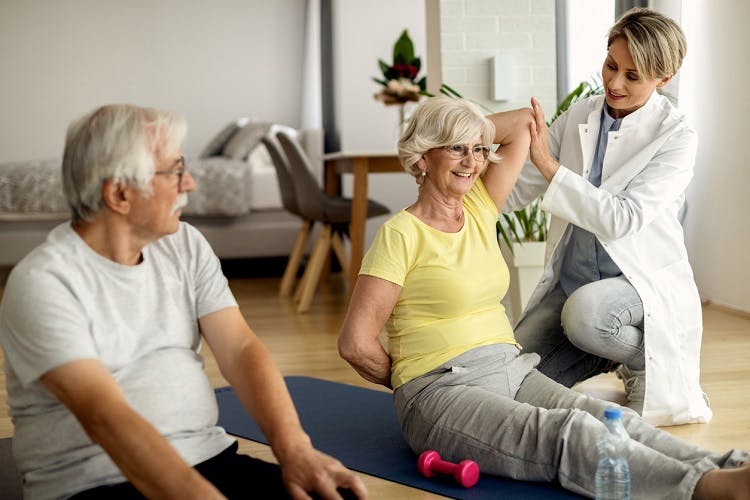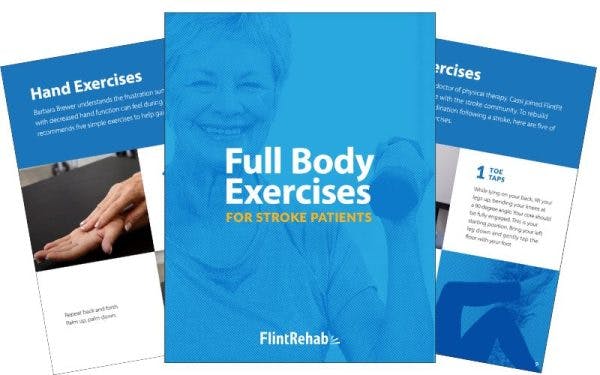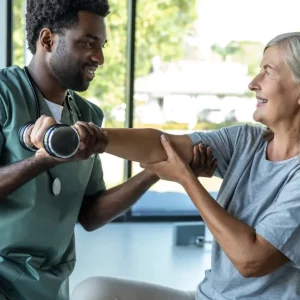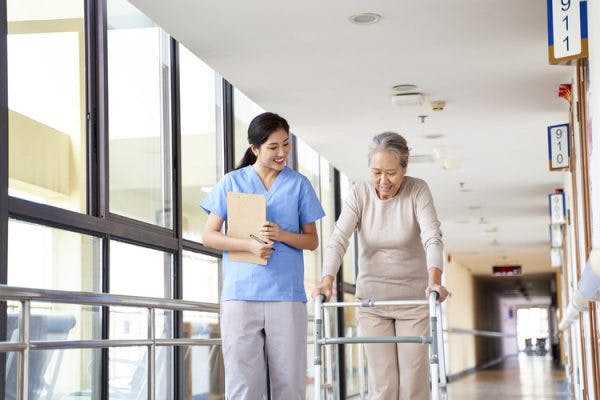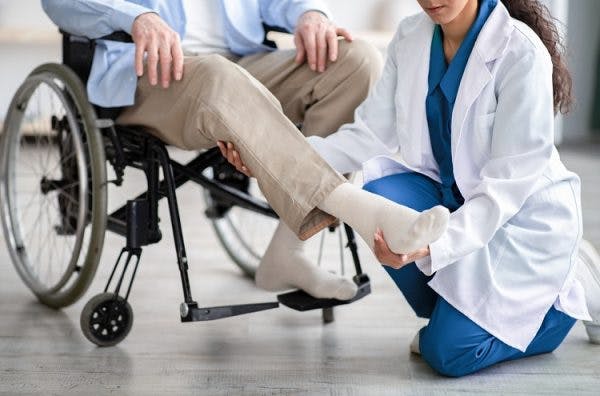After discharge from the hospital after a stroke, many survivors participate in outpatient therapy about once per week. However, this may not be enough to produce fast results. Fortunately, incorporating a home exercise program for stroke recovery can help keep the brain stimulated and encourage recovery to continue.
This article will discuss the benefits of post-stroke rehabilitation, as well as the various types of exercises you can include in your home exercise program for stroke recovery.
The Benefits of Exercise At Home After Stroke
A home exercise program after stroke allows survivors to improve mobility in the months and even years after discharging from therapy. Depending on the area of the brain affected by stroke, survivors have different secondary effects, and their home exercise program goals should be adjusted accordingly.
For example, survivors that sustained a stroke in the motor cortex may experience hemiparesis (weakness on one side of the body) and need a home exercise program that targets one side of the body more than the other. Survivors that sustained a cerebellar stroke may experience balance issues and need more focus on core exercises, which tend to be bilateral movements (involving both sides).
Fortunately, many survivors can overcome the effects of a stroke and improve functions with the help of neuroplasticity, the brain’s ability to rewire itself. When neural pathways in the brain become damaged or weakened after a stroke, neuroplasticity allows the brain to strengthen existing neural pathways and create new ones.
Neuroplasticity is best activated through high repetition of exercises, or massed practice. The more a skill is practiced, the more the brain strengthens the neural pathways for that skill. That’s where the saying “practice makes perfect” comes from.
While participating in outpatient therapy (like physical, occupational, or speech therapy) is helpful, it is often not enough time to practice to optimally engage neuroplasticity. Many survivors only attend only one session per week, limiting the amount of repetitions they can perform during therapy sessions and thus limiting the amount of stimulation to the brain.
Therefore, it’s imperative to continue rehabilitation after sustaining a stroke on a regular and consistent basis. Thus, a home exercise program for stroke recovery is essential to keep improving.
How to Create a Home Exercise Program for Stroke Recovery
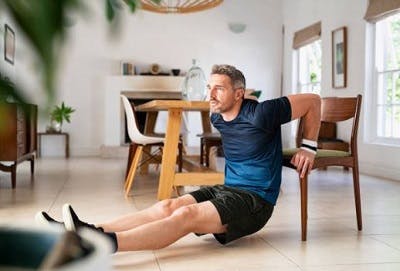
When creating a home exercise program for stroke recovery, it helps to keep a few things in mind. First, every exercise has its own challenges, and you should adjust the difficulty based on your ability level. Do not try to perform the most difficult exercises if you are starting from a place of very limited mobility.
The goal is to feel challenged but not frustrated by the exercises you practice. Feeling frustrated may cause you to lose the motivation to continue therapy. For example, if you struggle with paralysis, start with slow, passive exercises and work your way up to more difficult exercises.
Additionally, create a goal-oriented list of the different muscle groups you want to target. For instance, if you want to improve balance, you can target the core, legs, and arms; or if you want to improve hand function, you can focus specifically on hand exercises that help improve your fine motor skills.
Lastly, for all exercises remember to take breaks if you need to or stop completely when you feel you have run out of energy. Consult with your therapist if you have any questions or concerns about which exercises are suitable for you.
Passive Range of Motion Exercises for Stroke Rehabilitation at Home
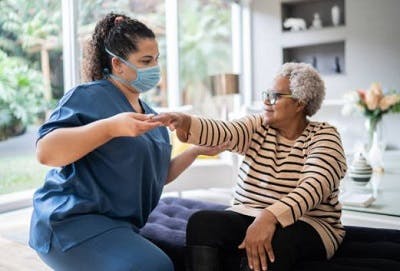
For survivors with hemiplegia (paralysis or severely limited mobility on one side of the body), it can be challenging to practice exercises actively, or through your own strength (without external assistance). Fortunately, passive range of motion exercises allow survivors to work on moving their joints through their full range of motion by assisting the affected side. By focusing intently on the movement, passive exercise can help stimulate neuroplasticity.
These exercises are great because they don’t require pre-existing movement and they help maximize the chances of slowly regaining movement on the affected side. With consistent practice of repetitive passive movements, the communication between your brain and muscles can improve and you may regain small amounts of mobility.
As you regain movement, or if you already have some existing movement, you can use passive range of motion exercises as warm ups before exercising at home.
Here are some independent passive range of motion exercises that you can include in your home exercise program for stroke rehabilitation:
- Forearm stretch: In a seated position, place your hands in your lap and then interlace your fingers. Then, bend your unaffected wrist forward, slowly stretching your affected hand back toward your forearm. Hold this stretch for a couple of seconds then release, and repeat with the other side if you are able.
- Inner arm stretch: This is a gentle arm stretch that begins by lacing your fingers together, then rotating your affected arm palm-side up. Hold for a couple of seconds, and stretch as much as you can. There may be some discomfort, especially when the muscles are tight, but no pain. Stop or take a break if this exercise does become painful.
- Straight push movement: Seated at a table, clasp your hands together and place your arms on the counter. Place a water bottle in front of you as your target, and then glide your arms across the table towards the water bottle. As you lean forward, stretch as much as you can and nudge the bottle further away. Return to an upright position and repeat, nudging the bottle a little more every time. It may help to place a towel under your hands during this exercise if you find that your skin seems to stick to the table.
- Circle movement: Clasp your hands around the water bottle, and slowly make big circle motions around the table, using your affected arm to help your unaffected arm move. Practice making a few circles clockwise, and then switch to counterclockwise.
Often, individuals with hemiplegia are able to perform passive range of motion exercises independently, using their unaffected side to move their affected side. This is one reason why these can be great exercises to complete at home.
However, it can also be helpful at times to have a therapist or trained caregiver perform passive range of motion exercises with you, especially if you have limited overall strength. Consider asking your therapist if they would recommend educating a caregiver to help you complete passive range of motion exercises to maximize your mobility.
Full-Body Exercises for Your Home Exercise Program
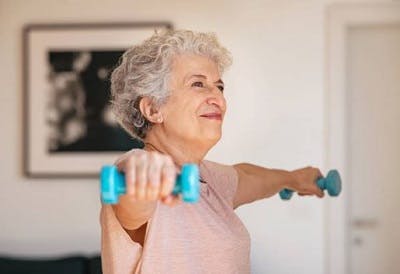
There are various types of active exercises you can do based on the muscles you want to target and your ability level. While passive exercises can be performed with the help of your unaffected side or assistance from a therapist, active exercises can be practiced on your own. However, it’s important to consult with your therapist before engaging in any exercise to make sure they are safe for your condition.
Hand Exercises
If you want to improve your fine motor skills after a stroke, consider adding these hand exercises to your home therapy program.
- Wrist bend movement: Resting your elbow on the table, use your unaffected hand to hold the forearm of your affected arm. Then, keeping your forearm still, slowly move your affected hand at the wrist in forward and backward directions.
- Object manipulation: Place five pennies on a table. Begin simply by picking up the pennies with your affected hand. After this becomes doable, use your affected hand to flip each penny over. You can also try using your affected hand to stack the pennies on top of each other. For an extra challenge, try to pick up the pennies, one by one, until you have all five held in your hand. When you are able to do this easily, start with holding all five pennies in your hand and work on moving each one to the tips of your index finger and thumb, to be set down one by one.
- Grip and release: Place a pen or something similar on one side of the table. Using your affected hand, gently grip the pen, then slide it across the table and release. Repeat this exercise by sliding the pen back across the table. Make sure to keep your forearm on the table to help prevent synergistic movement after stroke.
Synergistic movement occurs when you try to move one muscle group but another muscle group is unintentionally activated, such as hiking your shoulder when you attempt to move your arm. To prevent this from happening, make sure to practice slow, controlled movements.
Arm Exercises
To improve function in your arms, you can ask your therapist if these arm exercises are appropriate for your home therapy regimen after stroke.
- Cane reach: This is an exercise that helps improve mobility in your arm and shoulder muscles. To start, sit in a chair and hold both ends of a cane or yardstick. Use your unaffected side to gently push the affected arm up to the side. At this point, if the cane becomes challenging to hold onto, you can rest it on your leg for more stability. Hold this stretch for a few seconds before slowly releasing. To add to this exercise, you can turn your head and rotate your trunk to that side. As you become stronger, try moving your affected arm out to the side more actively, relying less on pushing your arm upward.
- Cane lift: Again, hold both ends of a cane in your hands. Lift both arms upwards, using your unaffected arm to help raise your affected arm as needed. If necessary, use a mirror to ensure you are not hiking your affected shoulder during this motion.
Leg Exercises
Leg exercises can also be incorporated in your home exercise program for stroke recovery. They can help improve your gait (manner of walking), balance, and muscle strength.
- Hip flexion with hold: If you have limited mobility, you can perform this exercise passively using your arms to assist you. Or if you want to increase the challenge, you can do this exercise actively on your own. This is especially great for individuals with limited mobility. While seated, use your hands to lift your affected leg up and in towards your chest. Hold for a few seconds before slowly setting your leg back down, then repeat with the other leg. If you are able to complete this actively, raise one leg at a time, as if you were marching in place. To add an extra balance challenge, try marching in place while standing. Ensure there is something sturdy, such as a chair, in front of you to support or catch yourself if needed.
- Inner thigh squeezes: This is a resistance training exercise that helps strengthen the legs and inner thighs (adductors), and reverse muscle atrophy after stroke. First, begin by making two fists and placing each one side by side between your knees. Then, slowly squeeze your fists and knees together and hold for as long as you can. Release and repeat.
Core Exercises
Core exercises are essential for stroke recovery because they help improve balance, gait, and reduce the risk of falling. A strong core helps provide stability for your entire body.
- Trunk rotation (twists): While in a seated position, place your right hand at the top of your left thigh. Using your arm, twist your torso to the left, making sure to keep your back straight and not to twist more than you can handle. Then, return to the center and repeat, alternating directions.
- Knees to chest: For this exercise, you may sit or lay in a comfortable position. Start by bringing your knees into your chest. Use your left arm to hold your left leg, and extend your right leg toward the floor. Then, bring your right leg back in towards your chest. Focus on engaging your core and using your core muscles to lift your leg upwards, not just your leg muscles. Then, squeeze your core muscles and slowly bring your leg back down. Repeat this exercise alternating between your legs.
As you pick and choose exercises to include in your home exercise program for stroke recovery, keep your goals and mobility level in mind. Any of these can be turned into passive exercises with assistance from a therapist or a caregiver, or they can be done actively on your own.
Gamified Devices for Your Home Exercise Program for Stroke
Maintaining a home exercise program can be challenging, especially if it is not very engaging or you are lacking motivation. Fortunately, technology for stroke rehabilitation can provide you with extra accountability and focus to achieve the high repetition you need for recovery.
For example, FitMi is a gamified neurorehabilitation device that was designed to improve full-body mobility after stroke. It’s an interactive home exercise program that helps you target different muscle groups including the core, hands, arms, and legs based on your ability level. FitMi also keeps track of your progress and unlocks more challenging exercises as you improve over time.
Take a look at this story from a stroke survivor who started using FitMi at home:
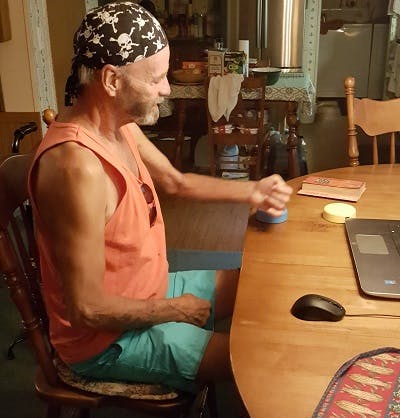
“I had a stroke last November, after my insurance stopped paying for therapy I got a bit depressed. After my wife found FitMi online we decided to give it a try and wow, I’m glad we did. I feel like I’m back in the fight, I’m gonna get better! This program provides me with great motivation, great workout, great reps! Thanks Flint Rehab, this is just what I needed, and just when I needed it.”
– James L.
FitMi is great for survivors at any stage in recovery. Whether you are currently attending therapy or have been out of therapy for some time, FitMi is a great addition to your home exercise program for stroke rehabilitation. It can help you get back on track and boost recovery, just like it did for James.
Engaging in a Home Exercise Program for Stroke
While participating in therapy once a week can be helpful, it is often not enough time to practice high repetition of exercises. Therefore, maintaining a home exercise program for stroke recovery is crucial to stimulate neuroplasticity and maximize recovery.
Stroke is a complex injury that can cause a variety of secondary effects such as hemiplegia or spasticity. Fortunately, these effects can be managed and reduced by staying engaged in rehabilitation after stroke, especially at home.
We hope this article helped you understand the importance of creating a home exercise program for stroke recovery, and encouraged you to try out these exercises.
